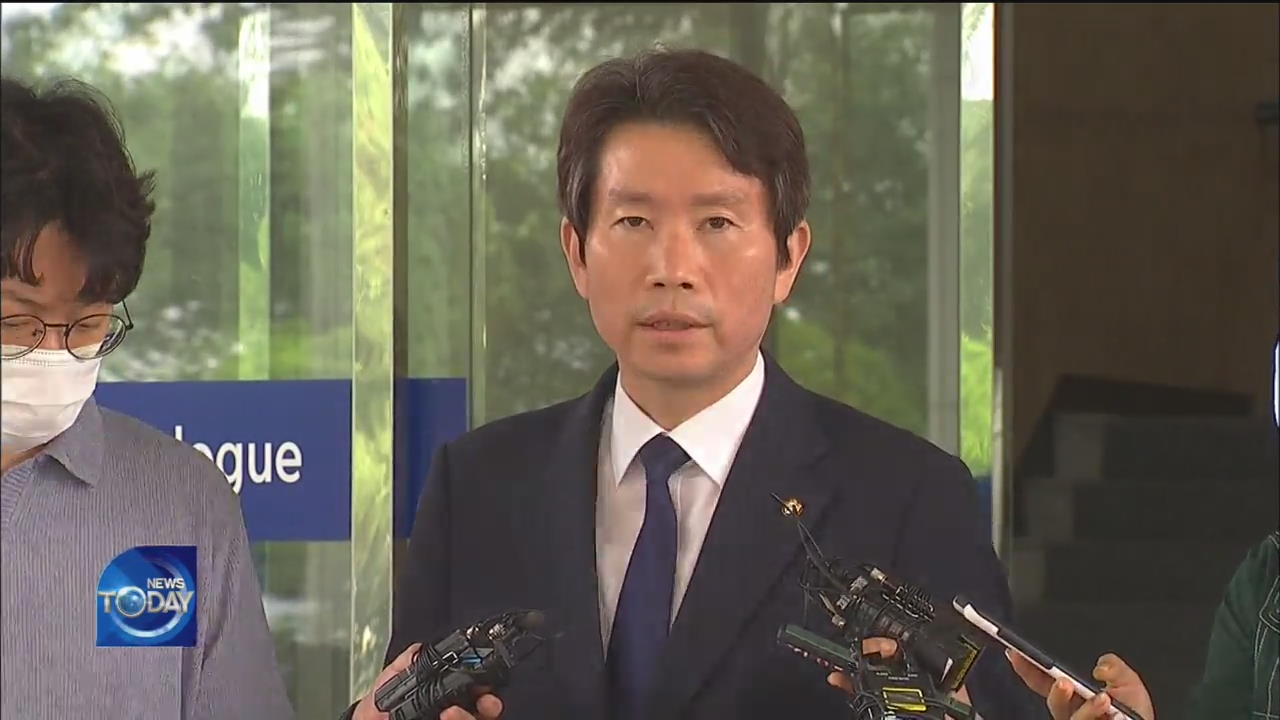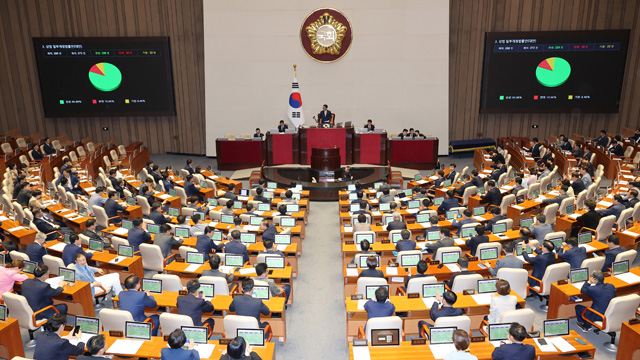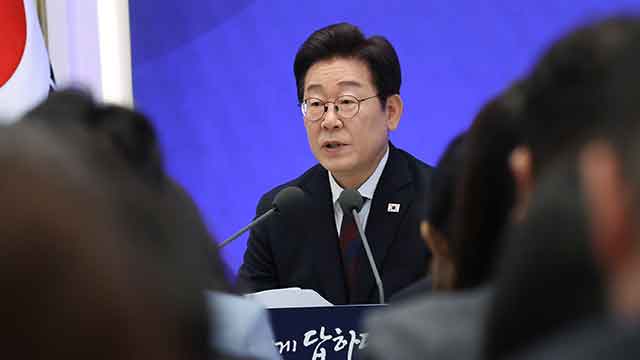WATER CONTAMINATED WITH BUGS AT FACILITIES
입력 2020.07.22 (15:39)
수정 2020.07.22 (16:46)
읽어주기 기능은 크롬기반의
브라우저에서만 사용하실 수 있습니다.
[Anchor Lead]
An investigation into water treatment facilities have found that seven of them had larvae in them. However, it hasn't been confirmed that these organisms reached households via tap water in areas other than Incheon where the first reports of contamination arose.
[Pkg]
Similar to the water treatment facility in Incheon, this facility in Gimhae, Gyeongsangnam-do Province, also uses activated carbon to purify water. One of the activated carbon filters at 17 water treatment tanks here has been found to contain 3 bugs.
[Soundbite] (STAFF AT SAMGYE WATER TREATMENT PLANT(VOICE MODIFIED)) : "Experts told us that it was the water insect, not the midge."
The environment ministry has inspected 49 water treatment plants nationwide that use activated carbon and found larvae in five areas in addition to the water treatment plants in Incheon and Bupyeong. In Incheon insects that had been found in activated carbon was also found in a distributing reservoir and household faucets. In the other five areas no larvae were found in places other than water treatment facilities. Experts presume that insect nets and other coverings installed at water plants cannot block larvae completely. However, it will likely take some time to figure out the exact cause of the problem, as two other water treatment facilities with proper insect nets have also been found to contain bugs.
[Soundbite] SHIN JIN-SOO(MINISTRY OF ENVIRONMENT) : "Currently there is a possibility of midges entering tap water pipes when they are open. We have set up a team of experts to conduct an in-depth investigation."
An investigation into 19 reports of insects in tap water received in Seoul and Busan has revealed that in most cases it was the larvae of flies and moths that permeated households through drains and ditches.
[Soundbite] LEE HYUN-DONG(KOREA INSTITUTE OF CIVIL ENGINEERING AND BUILDING TECHNOLOGY) : "Sometimes larvae are found in faucets although not in water treatment facilities or distribution reservoirs. Larvae enter faucets and later come out."
Now that the possibility of infestation has been confirmed, the ministry has requested local governments to report the problem to environmental authorities immediately.
An investigation into water treatment facilities have found that seven of them had larvae in them. However, it hasn't been confirmed that these organisms reached households via tap water in areas other than Incheon where the first reports of contamination arose.
[Pkg]
Similar to the water treatment facility in Incheon, this facility in Gimhae, Gyeongsangnam-do Province, also uses activated carbon to purify water. One of the activated carbon filters at 17 water treatment tanks here has been found to contain 3 bugs.
[Soundbite] (STAFF AT SAMGYE WATER TREATMENT PLANT(VOICE MODIFIED)) : "Experts told us that it was the water insect, not the midge."
The environment ministry has inspected 49 water treatment plants nationwide that use activated carbon and found larvae in five areas in addition to the water treatment plants in Incheon and Bupyeong. In Incheon insects that had been found in activated carbon was also found in a distributing reservoir and household faucets. In the other five areas no larvae were found in places other than water treatment facilities. Experts presume that insect nets and other coverings installed at water plants cannot block larvae completely. However, it will likely take some time to figure out the exact cause of the problem, as two other water treatment facilities with proper insect nets have also been found to contain bugs.
[Soundbite] SHIN JIN-SOO(MINISTRY OF ENVIRONMENT) : "Currently there is a possibility of midges entering tap water pipes when they are open. We have set up a team of experts to conduct an in-depth investigation."
An investigation into 19 reports of insects in tap water received in Seoul and Busan has revealed that in most cases it was the larvae of flies and moths that permeated households through drains and ditches.
[Soundbite] LEE HYUN-DONG(KOREA INSTITUTE OF CIVIL ENGINEERING AND BUILDING TECHNOLOGY) : "Sometimes larvae are found in faucets although not in water treatment facilities or distribution reservoirs. Larvae enter faucets and later come out."
Now that the possibility of infestation has been confirmed, the ministry has requested local governments to report the problem to environmental authorities immediately.
■ 제보하기
▷ 카카오톡 : 'KBS제보' 검색, 채널 추가
▷ 전화 : 02-781-1234, 4444
▷ 이메일 : kbs1234@kbs.co.kr
▷ 유튜브, 네이버, 카카오에서도 KBS뉴스를 구독해주세요!
- WATER CONTAMINATED WITH BUGS AT FACILITIES
-
- 입력 2020-07-22 15:40:08
- 수정2020-07-22 16:46:15

[Anchor Lead]
An investigation into water treatment facilities have found that seven of them had larvae in them. However, it hasn't been confirmed that these organisms reached households via tap water in areas other than Incheon where the first reports of contamination arose.
[Pkg]
Similar to the water treatment facility in Incheon, this facility in Gimhae, Gyeongsangnam-do Province, also uses activated carbon to purify water. One of the activated carbon filters at 17 water treatment tanks here has been found to contain 3 bugs.
[Soundbite] (STAFF AT SAMGYE WATER TREATMENT PLANT(VOICE MODIFIED)) : "Experts told us that it was the water insect, not the midge."
The environment ministry has inspected 49 water treatment plants nationwide that use activated carbon and found larvae in five areas in addition to the water treatment plants in Incheon and Bupyeong. In Incheon insects that had been found in activated carbon was also found in a distributing reservoir and household faucets. In the other five areas no larvae were found in places other than water treatment facilities. Experts presume that insect nets and other coverings installed at water plants cannot block larvae completely. However, it will likely take some time to figure out the exact cause of the problem, as two other water treatment facilities with proper insect nets have also been found to contain bugs.
[Soundbite] SHIN JIN-SOO(MINISTRY OF ENVIRONMENT) : "Currently there is a possibility of midges entering tap water pipes when they are open. We have set up a team of experts to conduct an in-depth investigation."
An investigation into 19 reports of insects in tap water received in Seoul and Busan has revealed that in most cases it was the larvae of flies and moths that permeated households through drains and ditches.
[Soundbite] LEE HYUN-DONG(KOREA INSTITUTE OF CIVIL ENGINEERING AND BUILDING TECHNOLOGY) : "Sometimes larvae are found in faucets although not in water treatment facilities or distribution reservoirs. Larvae enter faucets and later come out."
Now that the possibility of infestation has been confirmed, the ministry has requested local governments to report the problem to environmental authorities immediately.
An investigation into water treatment facilities have found that seven of them had larvae in them. However, it hasn't been confirmed that these organisms reached households via tap water in areas other than Incheon where the first reports of contamination arose.
[Pkg]
Similar to the water treatment facility in Incheon, this facility in Gimhae, Gyeongsangnam-do Province, also uses activated carbon to purify water. One of the activated carbon filters at 17 water treatment tanks here has been found to contain 3 bugs.
[Soundbite] (STAFF AT SAMGYE WATER TREATMENT PLANT(VOICE MODIFIED)) : "Experts told us that it was the water insect, not the midge."
The environment ministry has inspected 49 water treatment plants nationwide that use activated carbon and found larvae in five areas in addition to the water treatment plants in Incheon and Bupyeong. In Incheon insects that had been found in activated carbon was also found in a distributing reservoir and household faucets. In the other five areas no larvae were found in places other than water treatment facilities. Experts presume that insect nets and other coverings installed at water plants cannot block larvae completely. However, it will likely take some time to figure out the exact cause of the problem, as two other water treatment facilities with proper insect nets have also been found to contain bugs.
[Soundbite] SHIN JIN-SOO(MINISTRY OF ENVIRONMENT) : "Currently there is a possibility of midges entering tap water pipes when they are open. We have set up a team of experts to conduct an in-depth investigation."
An investigation into 19 reports of insects in tap water received in Seoul and Busan has revealed that in most cases it was the larvae of flies and moths that permeated households through drains and ditches.
[Soundbite] LEE HYUN-DONG(KOREA INSTITUTE OF CIVIL ENGINEERING AND BUILDING TECHNOLOGY) : "Sometimes larvae are found in faucets although not in water treatment facilities or distribution reservoirs. Larvae enter faucets and later come out."
Now that the possibility of infestation has been confirmed, the ministry has requested local governments to report the problem to environmental authorities immediately.
이 기사가 좋으셨다면
-
좋아요
0
-
응원해요
0
-
후속 원해요
0










![[HEADLINE]](https://news.kbs.co.kr/data/news/2020/07/22/4500025_10.jpg)






이 기사에 대한 의견을 남겨주세요.